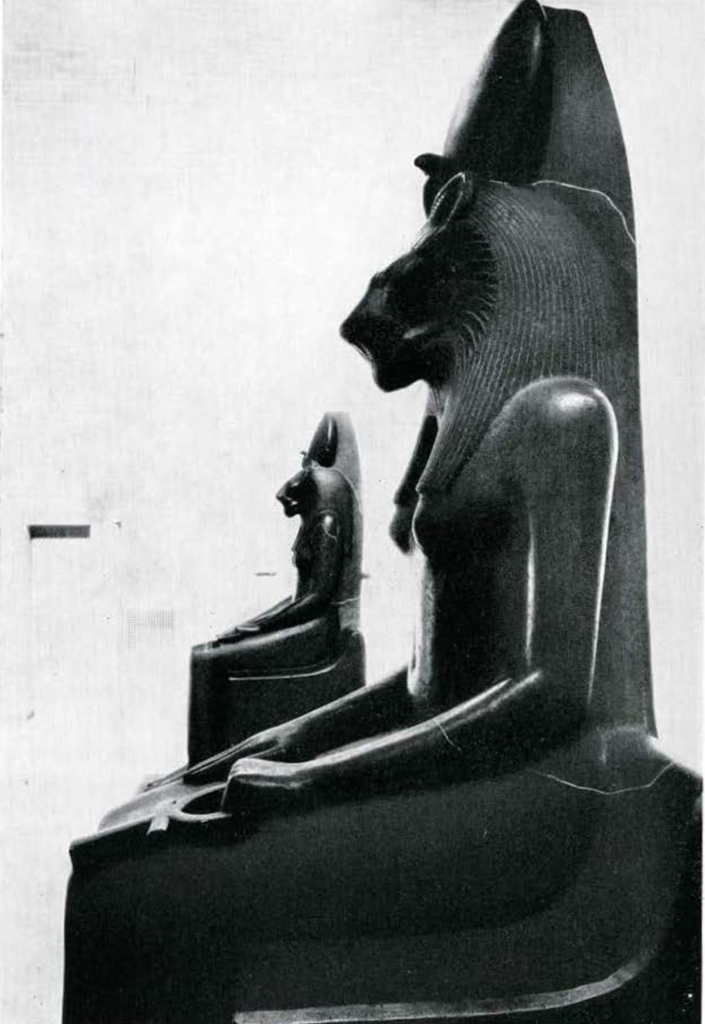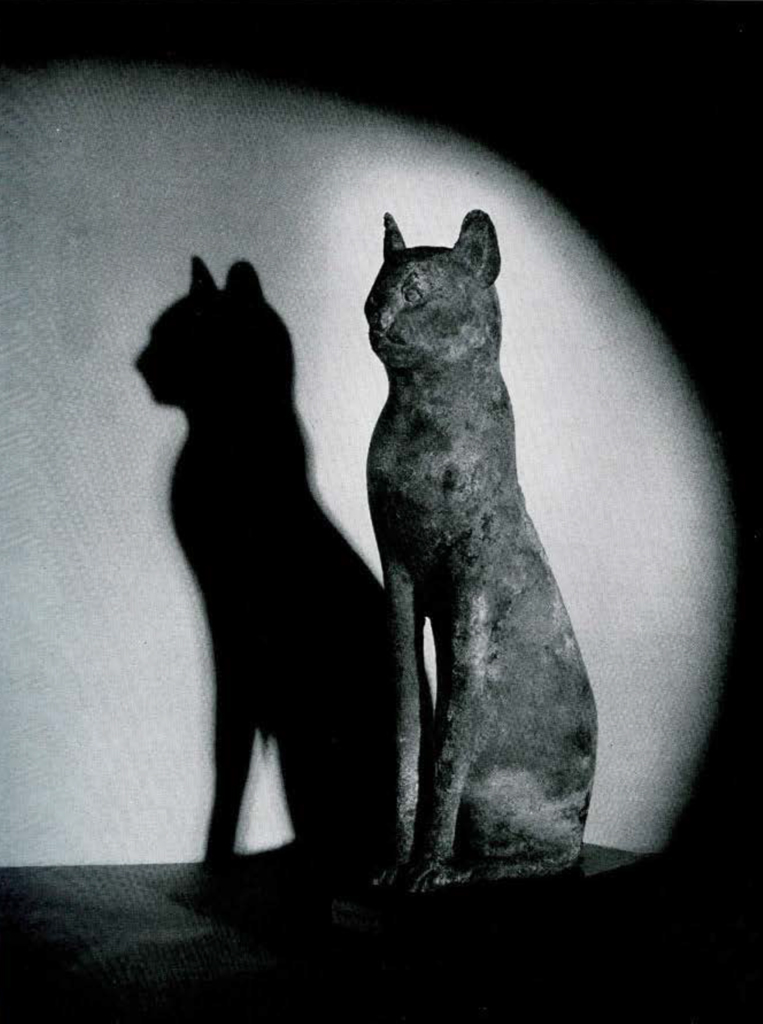The Egyptians, throughout their history, have been most god-fearing people. But they did not believe in only one god as we do. The whole of nature, for them, was filled with divine beings which appeared in trees and especially in animals and which they felt impelled to worship.

Museum Object Number: E2047 / E2048
Image Number: 147122
This is true of the wild fig tree-the “sycamore”-and of the palm tree, and it is true of a great many animals. Bull and cow, cat and dog, ram and goat were considered to be the incarnations of different deities, and so were lion and lioness, jackal and scorpion, crocodile and hippopotamus, the poisonous cobra (also called the “uraeus” serpent) and several birds, among them the falcon and the vulture.
After a time these animal deities came to be considered as more personalized beings, and the Egyptians expressed this by representing them in human form but with the head of a ram or a jackal or a cow or a falcon. Some of the deities even had several animals associated with them. Thus the ram as well as the goose belonged to Amon of Thebes. The baboon as well as the ibis was sacred to Thot, the great god of wisdom.
It is important to note that from earliest times some of the Egyptian deities were always represented in purely human form. This is not surprising in the case of Ma’at, the goddess of truth and justice, whose existence is due to an abstraction of the human mind. But it is remarkable in the cases of Atum, the sun god of Heliopolis, and of Nefertem, the son of Ptah, of Min the god of fertility, of Ptah the patron of craftsmen and artists, and of Osiris the great protector of the dead, who in later times became the best known and the most widely worshipped of all Egyptian deities. His wives Isis and Nephthys were also always depicted in purely human form, and so was his son by Isis, whose name has become familiar in its Greek form, Harpokrates (“Horus, the child”).
The following alphabetical list contains the names of the main deities worshipped in ancient Egypt, as mentioned in the guide. With each deity is listed the name of its center of worship and of the animal considered sacred to it.

Museum Object Number: E14284
Image Number: 31615
Amon, also identified with the sun god Re and then called Amon-Re. Worshipped at Thebes, Upper Egypt. Animals: ram and goose. Since the time of New Kingdom, chief god of all Egypt.
Anubis, worshipped as protector of the dead all over Egypt. Animal: jackal.
Apis; see “Ptah.”
Astarte, Syrian goddess, worshipped in Egypt since the New Kingdom.
Atum, worshipped at Heliopolis. Early identified with the sun god Re, usually in human form, often with the double crown of Upper and Lower Egypt. Animal: the bull Mnevis.
Bastet, goddess of joy, worshipped at Bubastis, Lower Egypt. Prominent during 22nd dynasty, whose kings resided at Bubastis. Animal: cat (fig. 4).
Bes, bowlegged dwarf-like god, introduced into Egypt in the Middle Kingdom. Protector of the bedroom. No animal.
Buchis; see Month.
Harakhte; see Horus.
Harpokrates; represented as a child sucking his finger. Son of Horus and Isis.
Harsaphes, worshipped at Heracleopolis, Upper Egypt. Animal: ram.
Hathor, goddess of love, protector of women. Worshipped at Dendereh, Upper Egypt. Animal: cow. Early identified with Isis.
Herishef, chief god of Heracleopolis, Upper Egypt. Animal: ram.
Horus, god of the sky. Also called Harakhte or “Horus rising in the horizon” and identified with the sun god Re (Re-Harakhte). Main places of worship: Hierakonpolis and Edfu, Upper Egypt. Animal: falcon. The four benevolent demons who took care of the inner parts of the mummified human body were called “Sons of Horus.”
Isis, sister and wife of Osiris. Usually in human form, and with the sign of her name, a throne, on her head. Early identified with Hathor and represented with cow’s horns. She had a temple at Iseum in the Delta and at Koptos was worshipped as consort of Min.
Khnum, god of the First Cataract, who formed mankind on the potter’s wheel. Animal: ram.
Khons, moon god, often with falcon head. Worshipped at Thebes as son of Amon and Mut.
Ma’at, goddess of truth and justice. Always human. Considered to be the daughter of Re. The hieroglyphic sign of her name, a feather, often seen on her head. No animal.
Mahesa, in Greek translation Miysis, god of Bubastis. Animal: lion.
Min, god of fertility, always human. Represented swathed like a mummy. Worshipped at Koptos, Upper Egypt. Protector of the desert routes. No animal.
Month, god of war, falcon-headed. Main sanctuaries at Hermonthis and Medamut, Upper Egypt. Animal: the bull Buchis.
Mut, mother goddess. Worshipped at Thebes as consort of Amon and mother of Khans. Temple at Karnak with its sacred lake of Asher. Animal: vulture.
Nefertem, worshipped at Memphis as son of Ptah. No animal. Emblem: lotus flower.
Neith, goddess, worshipped at Sai’s, Lower Egypt; wears crown of Lower Egypt. Chief deity under the 26th dynasty, whose kings resided at Sai’s. No animal.
Nekhbet, tutelary goddess of Upper Egypt, worshipped at Hierakonpolis, Upper Egypt. Animal: vulture.
Nephthys, sister and wife of Osiris. Always human. No animal.
Nut, goddess of the sky, always human. No animal. Sacred tree: sycamore.
Onuris, chief god of district of Thinis, Upper Egypt. Always human. No animal.
Osiris, protector and king of the dead. Worshipped at Busiris, Lower Egypt, but also at an early date throughout Egypt. Represented as a mummy, with an elaborate crown on his head. His main sanctuary at Abydos, Upper Egypt. Mostly accompanied by his sisters and wives Isis and Nephthys. No sacred animal.
Ptah, chief god of Memphis. Protector of artists and artisans. Always human. Represented swathed like a mummy, but with hands protruding. Animal: the bull Apis.
Re, sun god. Early identified with Atum of Heliopolis. Later with Harakhte and with Amon of Thebes. His daughter Ma’at. Always human. Sacred to him: the beetle (often represented with wings, in imitation of the winged sun-disk) and the uraeus serpent. See also Uto.
Sakhmet, goddess of war. Mostly with head of lioness. Identified with Mut of Thebes, in whose temple hundreds of statues of Sakhmet were erected (fig. 3).
Seth (or Setekh), god of Ombos, Upper Egypt. Also worshipped at Tanis, Lower Egypt. Developed into a god of war and was identified with the Semitic god Ba’al. After 22nd dynasty regarded as impure and inimical. Animal: unidentified mammal.
Shu, god of the air. Always human. Often the hieroglyph of his name, the feather, is on his head.
Sobk or Sukhos, god of the Fayyum. Animal: crocodile.
Sokaris, funerary deity, worshipped at Memphis. Represented with falcon head.
Thot, moon god and god of wisdom. Main sanctuary at Hermopolis, Upper Egypt. Animals: baboon and ibis.
Uto, tutelary goddess of Lower Egypt, worshipped at Buto, Lower Egypt. Animal: the uraeus serpent, which is also sacred to the sun god Re.
Wepwawet, funerary deity, worshipped at Assiut, Upper Egypt. Animal: wolf.

